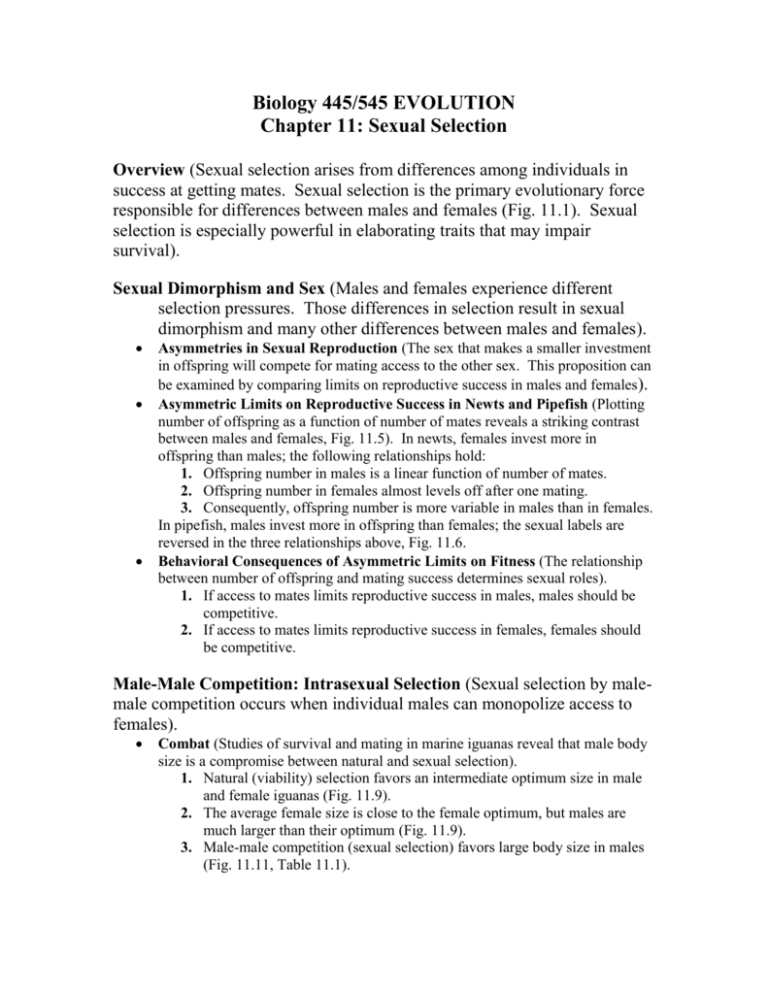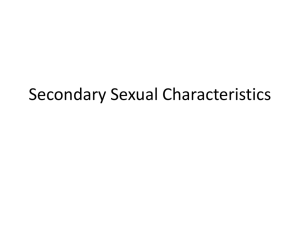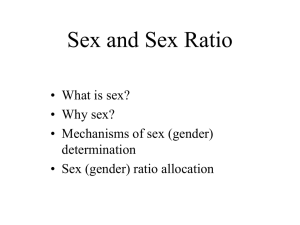Biology 445/545 EVOLUTION
advertisement

Biology 445/545 EVOLUTION Chapter 11: Sexual Selection Overview (Sexual selection arises from differences among individuals in success at getting mates. Sexual selection is the primary evolutionary force responsible for differences between males and females (Fig. 11.1). Sexual selection is especially powerful in elaborating traits that may impair survival). Sexual Dimorphism and Sex (Males and females experience different selection pressures. Those differences in selection result in sexual dimorphism and many other differences between males and females). Asymmetries in Sexual Reproduction (The sex that makes a smaller investment in offspring will compete for mating access to the other sex. This proposition can be examined by comparing limits on reproductive success in males and females). Asymmetric Limits on Reproductive Success in Newts and Pipefish (Plotting number of offspring as a function of number of mates reveals a striking contrast between males and females, Fig. 11.5). In newts, females invest more in offspring than males; the following relationships hold: 1. Offspring number in males is a linear function of number of mates. 2. Offspring number in females almost levels off after one mating. 3. Consequently, offspring number is more variable in males than in females. In pipefish, males invest more in offspring than females; the sexual labels are reversed in the three relationships above, Fig. 11.6. Behavioral Consequences of Asymmetric Limits on Fitness (The relationship between number of offspring and mating success determines sexual roles). 1. If access to mates limits reproductive success in males, males should be competitive. 2. If access to mates limits reproductive success in females, females should be competitive. Male-Male Competition: Intrasexual Selection (Sexual selection by malemale competition occurs when individual males can monopolize access to females). Combat (Studies of survival and mating in marine iguanas reveal that male body size is a compromise between natural and sexual selection). 1. Natural (viability) selection favors an intermediate optimum size in male and female iguanas (Fig. 11.9). 2. The average female size is close to the female optimum, but males are much larger than their optimum (Fig. 11.9). 3. Male-male competition (sexual selection) favors large body size in males (Fig. 11.11, Table 11.1). Sperm Competition (Competition between the sperm from rival males favors large ejaculates, prolonged copulation, copulatory plugs, and devices for removing the rival’s sperm, Fig. 11.15). Alternative Male Mating Strategies (Large and small males sometimes use different behavioral strategies to achieve mating success, Box 11.1, Figs. 11.13). Infanticide (In lions and other mammals, males that practice infanticide may have increases mating success, Fig. 11.16). Female Choice: Intersexual Selection (Mate choice can generate sexual selection if it results in differences in mating success and hence in reproductive success). Female Choice in Barn Swallows (Experimental manipulations of tail length in male red-collared widowbirds reveal that long tails are a liability for males, Fig. 11.18, but females prefer males with long tails, Fig. 11.19). Female Choice in Gray Tree Frogs (Experimental play-back of calls reveal that female gray tree frogs prefer fast, long calls, Fig. 11.21). Choosy Females May Get Better Genes for Their Offspring (Long calls by male gray tree frogs may be a indicator of good genes, Fig. 11.22, Table 11.2). Choosy Females May Benefit Directly Through the Acquisition of Resources (Female hanging flies favor mates that provide large nuptial gifts, Fig. 11.24). Choosy Females May Have Pre-existing Sensory Biases (A leg trembling display in male water mites may have evolved in response to a pre-existing sensory bias in females that allowed them to detect prey, Figs. 11.25-26). Other Explanations for Female Choice (Male ornaments may evolve because they are attractive to females even if they do not advertise good genes, Box 11.2, Figs. 11.29-30. In such cases, female preference may evolve as a correlated response to selection on male traits, Fig. 11.31). Sexual Selection on Females (In some species of pipefish, males brood eggs and females compete for access to mates, Fig. 11.34. Such ‘sex-role reversal’ is found in other species in which males are responsible for parental care). Sexual Selection in Plants (Showy floral traits are associated more with pollenparentage than with seed-parentage in plants). Male reproductive success in radishes is limited by pollinator visits, but female reproductive success is not, Fig. 11.36. Comparative studies indicate that the showy part of the flower serves a protective function in wind-pollinated plants but promotes male function in insect-pollinated plants, Fig. 11.37. Primary Study Questions: 1. The two major categories of sexual selection are (what)? 2. What is the definition of sexual selection? 3. Why did Darwin distinguish between natural and sexual selection? 4. What is the relationship between parental investment and sex roles? 5. What evidence do we have that male-male competition does not end with copulation? 6. Multiple male behaviors for achieving mating success within a single populations are called (what)? 7. Why are alternative male mating strategies usually size related? 8. What is the evidence for sexual selection in plants? 9. In pipefish, males may provide greater (what?) than females. 10. What are the characteristics of a ‘sex-role reversed’ species? Secondary Study Questions: 1. What is the evidence that natural (viability) and sexual selection are opposing forces in marine iguanas? 2. What does a female hanging fly gain from receiving a larger nuptial gift? 3. What does a male hanging fly gain from presenting a larger nuptial gift? 4. What does it mean to say that a female gets good genes from her mate choice? 5. What is the significance of a difference between males and females in relationship between number of offspring as a function of number of matings? 6. What does it mean to say that a male’s mating display is arbitrary? 7. A genetic correlation between the sexes can cause (what?) to evolve as a consequence of sexual selection on male character. 8. Copulatory plugs are a form of (what?) competition? 9. Why is it problematic to argue that sexual selection has resulted in particular differences between the sexes in human populations? 10. Under what circumstances can infanticide be favored by selection? Sexual selection models: http://oregonstate.edu/~uyedaj/sexualselection.html








